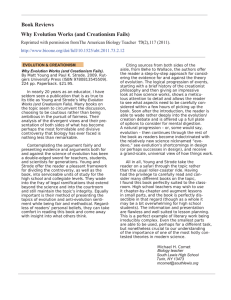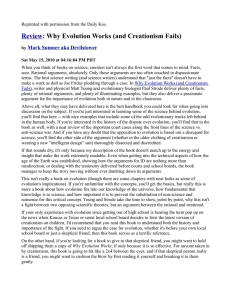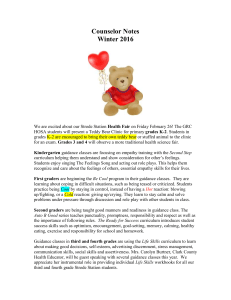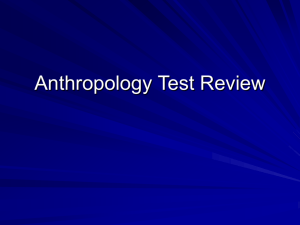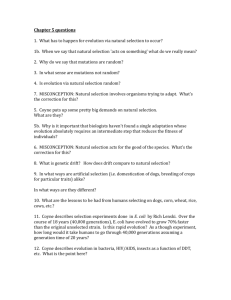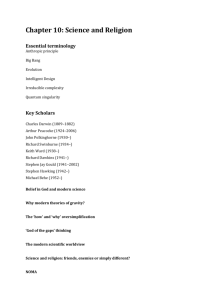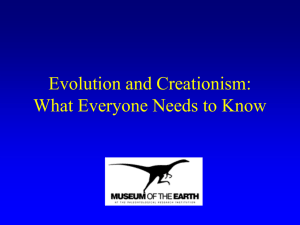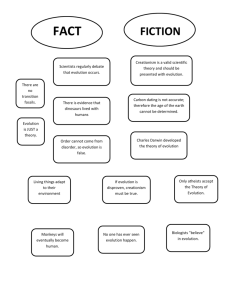358
advertisement
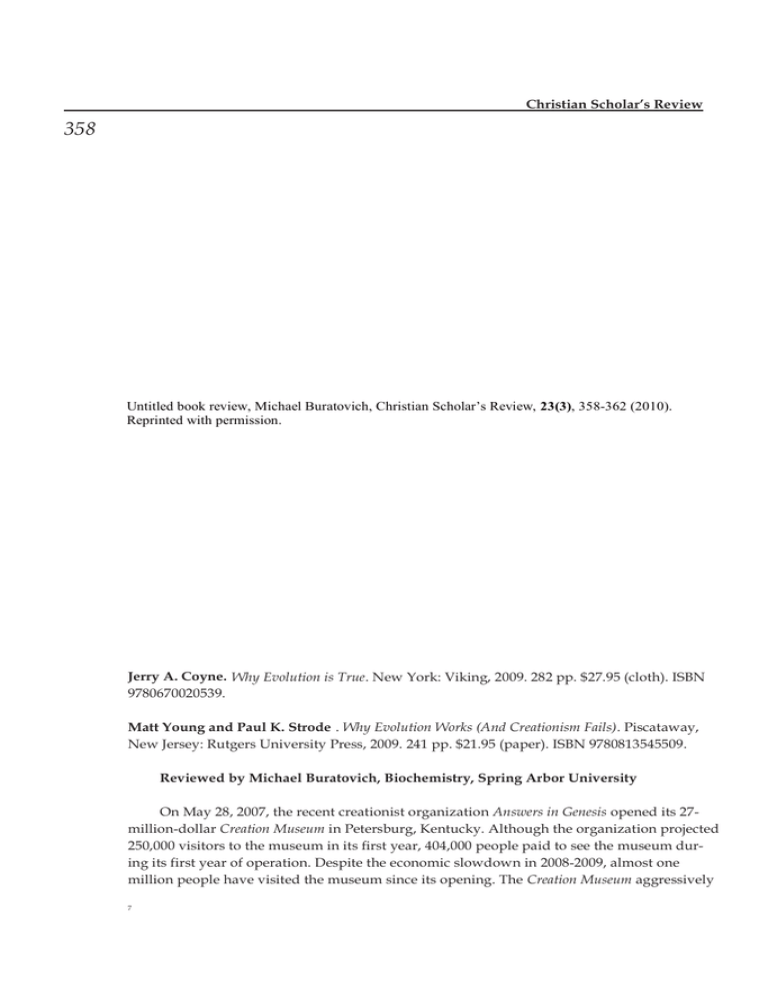
Christian Scholar’s Review 358 Untitled book review, Michael Buratovich, Christian Scholar’s Review, 23(3), 358-362 (2010). Reprinted with permission. Jerry A. Coyne. Why Evolution is True. New York: Viking, 2009. 282 pp. $27.95 (cloth). ISBN 9780670020539. Matt Young and Paul K. Strode . Why Evolution Works (And Creationism Fails). Piscataway, New Jersey: Rutgers University Press, 2009. 241 pp. $21.95 (paper). ISBN 9780813545509. Reviewed by Michael Buratovich, Biochemistry, Spring Arbor University On May 28, 2007, the recent creationist organization Answers in Genesis opened its 27million-dollar Creation Museum in Petersburg, Kentucky. Although the organization projected 250,000 visitors to the museum in its first year, 404,000 people paid to see the museum during its first year of operation. Despite the economic slowdown in 2008-2009, almost one million people have visited the museum since its opening. The Creation Museum aggressively 7 Reviews promotes a young earth and universe, flood geology, contemporaneous existence of almost all fossil creatures, and attacks the Neo-Darwinian theory of biological evolution vigorously. The broad exposure of the American public to the Creation Museum and, consequently, the arguments for Recent Creationism promulgated by organizations like Answers in Genesis, has motivated mainstream scientists to articulate and clarify their views of biological evolution and why they embrace it. Two popular books on the theory of biological evolution that attempt to do just that are Jerry Coyne’s Why Evolution is True and Matt Young and Paul Strode’s Why Evolution Works (and Creationism Fails). Both of these books are very readable and provide useful summaries of evolutionary theory. They also attempt to provide evidence for the contemporary NeoDarwinian theory of biological evolution and demonstrate that this theory does a better job of explaining the existence and origin of biological diversity than competing theories like Intelligent Design (ID) theory and Recent or Progressive Creationism. Jerry Coyne, a professor of evolution and ecology at the University of Chicago, is blessed with a remarkable ability to write clearly. Consequently his book is masterfully organized and written. In the opening chapter, Coyne specifies six characteristics of the Neo-Darwinian theory of biological evolution, and notes six predictions that result from it. If Neo-Darwinism is a robust description of how life changes through the passage of geologic time, then an examination of life on this planet should confirm these six predictions. The rest of the book examines the evidence from the fossil record, structure of plants and animals, geographic distribution of animals, evidence for natural selection in the wild, sexual selection, formation of new species, and evolutionary studies of human populations. According to Coyne, data from these fields confirms all six predictions. Coyne does not attempt to provide every single example and “carpet bomb” the reader with details. Instead he focuses on the most salient points. In his discussion of the fossil record, he documents several transitions between various animal groups and concludes that the fossil record confirms three predictions made by evolutionary theory: “gradual change within lineages, splitting of lineages, and the existence of transitional forms between very different kinds of organisms” (53). He also notes that anatomical innovations are made by remodeling old structures, which is also an expectation of Neo-Darwinism. In his summary of animal bodies and development, he finds examples of structures that have lost their original function, poor design, and developmental pathways that seem circuitous. Such features “make sense only if they evolved from features of earlier ancestors” (85). In a chapter on the geography of life, he sees different creatures that occupy virtually identical environments and “fundamentally different animals that nevertheless look and act so alike” (92). Such observations are also explained better by Neo-Darwinism than its alternatives, according to Coyne. Then he briefly surveys field studies that demonstrate that natural selection definitely occurs in the wild, explains the evidence for sexual selection, and shows that it explains sexual dimorphism in species beautifully. His final chapters include a succinct summary of the human fossil record and an attempt to synthesize what it all means. Coyne’s conclusion is that detailed studies of biology forcefully confirm the six predictions made at the beginning of the book. He concludes: “[W]e should be proud that we are the only species that has figured out how we came to be” (233). The other book by Young and Strode is not nearly as detailed as the Coyne book. Matt Young, who is in the Physics department at the Colorado School of Mines, and Paul Strode, a high-school biology teacher in Boulder, Colorado, have written a book for readers who have little to no science training. The main targets for this book seem to be parents, school 359 Christian Scholar’s Review 360 board members, educators, and other people involved in the origins debates who need a quick, easy-to-read science guide within their reach. The chapters are quite short and more detailed explanations are found in text boxes throughout each chapter. Another significant difference between this book and Why Evolution is True is the emphasis on the ID movement in the Young and Strode book. While they mention Recent Creationism and address some of its objections to Neo-Darwinism, Young and Strode note that the Supreme Court outlawed the teaching of “Creation Science” in its 1987 Edwards v. Aguillard case. Therefore, for their purposes, Young and Strode see Recent Creationism as a toothless tiger, and tend to focus more on the new challenger to Neo-Darwinism, ID theory. Young and Strode begin with an introduction that explains the importance of evolutionary biology to modern medicine and other fields as well. Next, they outline the history of Creationism and its interaction with the American legal system. Clearly these authors see the ID movement as an extension of Creationism, even though they tend to treat their arguments differently. The next section examines the nature of science and compares it with pseudoscience. The authors describe the tenets of Recent and “Old-Earth” Creationism and the argument from design, and conclude that both resemble pseudoscience much more than they do science. Young-Earth Creationism, in their view, fails because “its claim that the earth is a few thousand years old is, frankly contrary to fact” (55), and Old-Earth Creationism fails because “it feels compelled to force-fit the chronology of the Bible to the known chronologies of geology and evolution. Not only is the fit not good; the evidence in its favor is also lacking” (57). The final chapter in this section critiques the argument from design. The next section examines the theory of biological evolution and the first chapter in this section discusses Charles Darwin and how he came to propound his theory of natural selection. The next chapter gives a bird’s-eye view of Neo-Darwinism and its explanatory power. The last two chapters in this section discuss Ernst Haeckel’s “biogenic law,” which specified that “the path of an organism during its embryological development (ontology) is a summary of its evolutionary history (phylogeny)” (99). This chapter is a clear attempt to rebut the claims of ID proponent Jonathan Wells, whose book Icons of Evolution claims that Haeckel’s biogenic law is still taught in high school and college textbooks. Young and Strode assert that modern biologists eschew Haeckel’s biogenic law, and instead use von Baer’s law, which asserts that “the embryos of higher animal forms resemble the embryos, not the adults, of earlier forms” (100). This is followed by a chapter about the more recent field of evo-devo, which examines anatomical changes that are wrought by slight changes in early development. These two chapters are the most useful in the entire book. This section is capped by a chapter that explains phylogenetics, which uses computers to make “trees of life” that specify the evolutionary relatedness between organisms, and another chapter that details examples of poor design. The penultimate section examines how geochronologists determine the age of the earth and universe objectively, followed by a chapter that critiques the design hypothesis for the universe. The final section examines the evolution of morality and the compatibility of science and religious thinking. A useful glossary and bibliography complete the book. Both books make strong cases for Neo-Darwinism and offer substantial criticisms of Creationism. Coyne’s book also manages to do so without sounding patronizing or condescending. Young and Strode, however, have written a book for non-Christians and they simply cannot help making digs at Christianity. For example, they characterize biblical higher criticism as a “careful, dispassionate effort to deduce the origin, age or veracity of various sections of the Bible” (21), but higher critics of the Bible are often anything but objective, and Reviews anyone who has ever listened to Elaine Pagels or Bart Ehrman can testify to this. Some of their digs are also undocumented and gratuitous. For example, they write: “[T]he Hebrew Bible consists of several discrete, interwoven threads that tell inconsistent stories” (22), but never cite a single example. Also, the explanations that these books give for the evolution of morality can explain the origin of cultural mores, but they do not explain the origin of objective moral standards. Kin selection might explain why we are kind to those who are genetically related to us, but it cannot explain why people will risk their lives for total strangers. To explain this behavior Young and Strode cite the work of primatologist Frans de Waal and his concept of “reciprocal altruism” where chimps will come to the aid of nonrelatives for a delayed payoff. While the work of de Waal suggests that chimpanzees have some rudimentary understanding of morality, we must remember that chimps engage in this “premoral” behavior in order to get something in return. Humans, on the other hand, will sometimes do the right thing as matter of principle, regardless of self-interest. Furthermore, much of de Waal’s work involves observations of interactions between captive chimps. Because we cannot ask the chimps why they behaved the way they did, de Waal’s interpretation may or may not be correct. Anthropomorphism is a common pitfall in the field of animal behavior. Therefore chimps may not have the understanding of morality that sympathetic human observers actually impute to them. However, the problems with this explanation do not end there. Even though computer programs like Tit for Tat or the theoretical constructs like the Prisoner’s Dilemma can illustrate the construction of social rules of behavior, they cannot explain the existence of transcendent moral standards. If such standards do not exist, then is Mother Teresa really a better person than Adolph Hitler? Is rape or torturing babies for fun always wrong? Is moral progress possible? If objective moral standards do not exist, then the answer to all these questions must be no, and we are left with absurdities. The abolition of slavery and Jim Crow laws in the United States under such moral relativism is not moral progress but only moral change. If we are not willing to accept such absurdities, then we must explain the existence of objective moral standards. In this case a completely material process like Neo-Darwinism, while it can explain the origin of our moral sense, cannot account properly for the origin or existence or objective moral standards. Young and Strode make it clear that they accept moral relativism, but they have not addressed the difficulties that it raises. Finally, in their chapter on the cosmological case for design, Young and Strode use the computer simulations of physicist Victor Stenger to cast doubt on the fine-tuning argument. However, Stenger’s “toy universes” simulations are computer-generated universes that have variations in various physical constants. Such computer modeling is hardly a realistic view of what such universes would look like. Instead, they prefer the multiverse hypothesis, but even a many-universe generator has to be fine-tuned in order to make a universe like ours, and therefore, the multiverse hypothesis only delays the inevitable problem. Furthermore, we also have no reliable evidence for the existence of alternative universes or superstring theory, which also is required for the multiverse hypothesis. The “God hypothesis” seems like a simpler solution to the problem of the universe’s fine tuning. In conclusion, both books are fine representations of a solid mainstream defense of evolutionary theory against Creationism and ID theory. While not all of their defenses are equally convincing, both books are highly readable and user-friendly. Those who desire more details should read the Coyne book, but those who want more of a response to ID theory should read Young and Strode. If you are really interested in the mainstream scientific re- 361 Christian Scholar’s Review 362 sponse to challenges to Neo-Darwinism, read both books.
